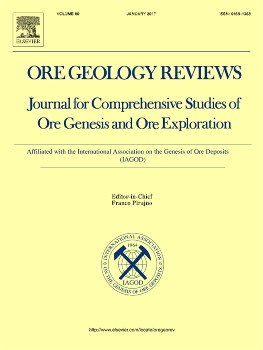
Importance of hydrogeological conditions during formation of the karstic bauxite deposits
Karstic bauxite deposits are widespread in Central Guizhou Province, SW China, and high-grade ores are frequently sandwiched with overlying coal and underlying iron-rich layers and form a special “coal–bauxite–iron” structure. The Lindai deposit, which is one of the most representative karstic bauxite deposits in Central Guizhou Province, was selected as a case study. Based on textural features and iron abundances, bauxite ores in the Lindai deposit are divided into three types of ores, i.e., clastic, compact, and high-iron. The bauxite ores primarily comprise diaspore, boehmite, kaolinite, illite, and hematite with minor quartz, smectite, pyrite, zircon, rutile, anatase, and feldspar. The Al2O3 (53–76.8 wt.%) is the main chemical contents of the bauxite ore samples in the Lindai district, followed by SiO2, Fe2O3, TiO2, CaO, MgO, S, and P etc. Our geological data on the Lindai deposit indicated that the ore-bearing rock series and its underlying stratum have similar rare earth elements distribution pattern and similar Y/Ho, Zr/Hf, and Eu/Eu∗ values; additionally, all ore-bearing rock samples are rich in MgO (range from 0.16 wt.% to 0.68 wt.%), and the plots of the dolomites and laterites lie almost on or close to the weathering line fit by the Al-bearing rocks in Zr vs. Hf and Nb vs. Ta diagrams; suggesting that the underlying Middle Cambrian Shilengshui Formation dolomite is the parent rock of bauxite resources in the Lindai district.
Simulated weathering experiments on the modern laterite from the Shilengshui Formation dolomite in the Lindai bauxite deposit show that hydrogeological conditions are important for karstic bauxite formation: Si is most likely to migrate, its migration rate is several magnitudes higher than those of Al and Fe under natural conditions; the reducing inorganic acid condition is the most conducive to Al enrichment and Si removal; Fe does not migrate easily in groundwater, Al enrichment and Fe removal can occur only in acidic and reducing conditions with the presence of organic matter.
The geological and experimental studies show that “coal–bauxite–iron” structure in Lindai deposit is formed under certain hydrogeological conditions, i.e., since lateritic bauxite or Al-rich laterite deposited upon the semi-closed karst depressions, Si can be continuously removed out under neutral/acidic groundwater conditions; the coal/carbonaceous rock overlying the bauxitic materials were easily oxidized to produce acidic (H2S, H2SO4, etc.) and reductant groundwater with organic materials that percolated downward, resulting in enrichment of Al in underlying bauxite; it also reduced Fe3+ to its easily migrating form Fe2+, moving downward to near the basal carbonate culminated in precipitating of ferruginous (FeS2, FeCO3, etc.) strata of the “coal–bauxite–iron” structure. Thus, the bauxitic materials experienced Al enrichment and Si and Fe removal under above certain hydrogeological conditions forming the high-quality bauxite.
source: https://www.sciencedirect.com